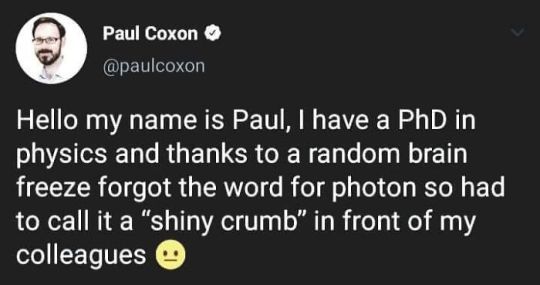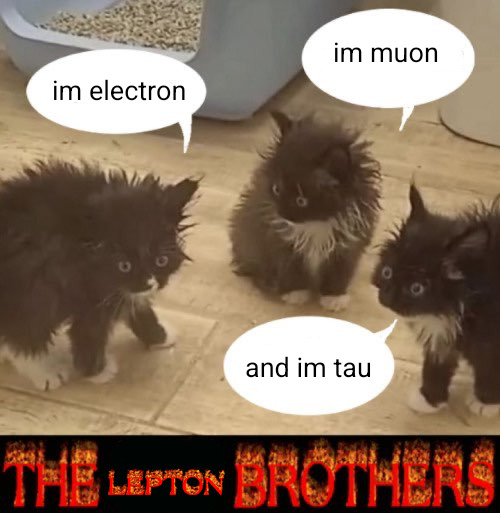#particle physics
Explore tagged Tumblr posts
Text

Mathematical methods point to possibility of particles long thought impossible
From the early days of quantum mechanics, scientists have thought that all particles can be categorized into one of two groups—bosons or fermions—based on their behavior. However, new research by Rice University physicist Kaden Hazzard and former Rice graduate student Zhiyuan Wang shows the possibility of particles that are neither bosons nor fermions. Their study, published in Nature, mathematically demonstrates the potential existence of paraparticles that have long been thought impossible. "We determined that new types of particles we never knew of before are possible," said Hazzard, associate professor of physics and astronomy.
Read more.
43 notes
·
View notes
Text

My latest cartoon for New Scientist
9K notes
·
View notes
Text
good morning electrons good morning muons good morning taus good morning neutrinos good morning quarks good morning bosons
196 notes
·
View notes
Text
a very fun fact about particle physics is that it allows us to tell aliens what "left" and "right" are
#particle physics#obviously it's mostly a challenge for the linguists#but once you're able to talk to the aliens in the first place you need particle physics for left and right#this is about talking on the radio of course. if you meet in person you can just point
4 notes
·
View notes
Text

Ugh they are always doing this
68 notes
·
View notes
Text

181 notes
·
View notes
Text
Scientists have made a satisfying and intriguing physics discovery some 16 years after it was first predicted to be a possibility: a quasiparticle (a group of particles behaving as one) that only has an effective mass when moving in one direction. In physics, mass generally refers to a property of particles that relates to things like their energy and resistance to movement. Yet not all mass is built the same – some describes the energy of a particle at rest, for example, while mass may also take into account the energy of a particle's motion. In this case, the effective mass describes the quasiparticle's response to forces, which varies depending on whether the movement through the material is up and down, or back and forth. Whereas regular quasiparticles have the same mass no matter what their direction of travel, the semi-Dirac fermion (to give it its technical name) being studied here doesn't seem to play by the normal rules.
Continue Reading.
164 notes
·
View notes
Text

#Superconducting Super Collider#Particle Physics#Texas#CERN#Large Hadron Collider#Science History#Canceled Projects#U.S. Science Initiatives#High-Energy Physics#Scientific Funding#physics#science
112 notes
·
View notes
Text

Attracted to the Core
#particle physics#system#black and white#attraction#artists on tumblr#circles#dots#core#visuals#loop#seamless#trapcode#particular#after effects#motion#daily#evasion
132 notes
·
View notes
Text

[6/8/24] i got a result for my calculations,,,, but at what cost? Mathematica was being mean to me so i ended up graphing it on desmos instead which told me that my code wasn’t wrong,,,, i just didn’t expect the results! anyway, idk what to tell my prof bc i got this far without having the faintest clue abt what quantum mechanics is!
i did find a cool new study nook in one of my favourite buildings tho. might abandon my office in its favour
#physics#min vs college#studyblr#college#min vs summer24#study aesthetic#particle physics#physics studyblr
268 notes
·
View notes
Text

My latest cartoon for New Scientist.
8K notes
·
View notes
Text

504 notes
·
View notes
Text

I made this after dumping a bunch of info about leptons onto my friend today skfjdkkdjd
#physics#particle physics#nuclear physics#leptons#electrons#tau#muon#local autistic likes subatomic particles#subatomic particles#quarks#the lepton brothers#i fucking love subatomic particles
341 notes
·
View notes
Text

some physics valentines from your favourite plant biology blog. may your love last longer than the half-life of a proton
#particle physics#i made these a few years ago back when i was still in the depths of e&m hell#good times#hope u guys enjoy them#valentines day#im aroace but its ok my love for physics is mediated by gauge bosons not romantic attraction#physics#high energy physics#math#mathblr#linear algebra#maths#string theory#i guess lmAO??
31 notes
·
View notes
Text
Did you see the muon headlines? What actually changed?

View On WordPress
12 notes
·
View notes
Text
In 1956, theoretical physicist David Pines predicted that electrons in a solid can do something strange. While they normally have a mass and an electric charge, Pines asserted that they can combine to form a composite particle that is massless, neutral, and does not interact with light. He called this particle a "demon." Since then, it has been speculated to play an important role in the behaviors of a wide variety of metals. Unfortunately, the same properties that make it interesting have allowed it to elude detection since its prediction. Now, a team of researchers led by Peter Abbamonte, a professor of physics at the University of Illinois Urbana-Champaign, have finally found Pines' demon 67 years after it was predicted. As the researchers report in the journal Nature, they used a nonstandard experimental technique that directly excites a material's electronic modes, allowing them to see the demon's signature in the metal strontium ruthenate. "Demons have been theoretically conjectured for a long time, but experimentalists never studied them," Abbamonte said. "In fact, we weren't even looking for it. But it turned out we were doing exactly the right thing, and we found it."
Continue Reading
433 notes
·
View notes